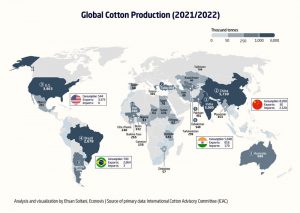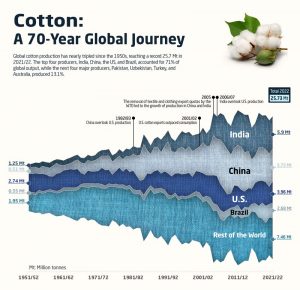Cotton is a soft, fluffy staple fiber that grows in a boll or protective sheath around the seeds of the cotton plant. The plant is a shrub native to tropical and subtropical regions around the world, and its use for fabric dates back to prehistoric times.
Cotton production accounts for 2.5 percent of the world’s arable land. Until the 1980s, cotton was the dominant fiber, accounting for about half of all textile fiber consumption. However, since the 1980s, consumption of chemical fibers (mainly polyester) has overtaken cotton, and the share of cotton in the total consumption of textile fibers decreased to 24 percent in 2020.
Despite the decline in its market share, cotton remains an important fiber in the global textile industry. It is a versatile fiber that can be used to create a wide range of products, from delicate garments to durable workwear. Cotton is also a sustainable fiber, as it can be grown and processed with minimal environmental impact.
Global cotton production has nearly tripled since the 1950s, reaching a record 25.7 million metric tons (Mt) in 2021-22. The top four producers, India, China, the United States, and Brazil, accounted for 71 percent of global output, while the next four major producers, Pakistan, Uzbekistan, Turkey, and Australia, produced 13.1 percent.
India’s cotton production has surpassed China’s since 2015-16. India’s cotton production more than doubled between the 1970s and 1990s, and then increased by 146 percent between the 1990s and 2010s. India is the second-largest consumer and third-largest exporter of cotton in the world, exporting 816 Mt of cotton in 2021-22.
China’s cotton production doubled between the 1970s and 1990s, reaching a peak of 8,070 Mt in 2007-08. However, production declined in the 2010s, falling to 5,730 Mt in 2021-22. China is the world’s largest consumer and importer of cotton, with consumption of 8,200 Mt and imports of 2,520 Mt in 2021-22.
 India and China’s share of global cotton production rose from approximately 22 percent in the 1940s-1960s to 36 percent in the 1980s-1990s, and then to 45 percent and 48 percent in the 2000s and 2010s, respectively. The removal of textile and clothing export quotas by the World Trade Organization in 2005 is widely credited with driving this growth.
India and China’s share of global cotton production rose from approximately 22 percent in the 1940s-1960s to 36 percent in the 1980s-1990s, and then to 45 percent and 48 percent in the 2000s and 2010s, respectively. The removal of textile and clothing export quotas by the World Trade Organization in 2005 is widely credited with driving this growth.
The United States was once the world’s leading producer of cotton, but China surpassed it in 1982-83. U.S. cotton production increased steadily from 2.7 Mt in the 1940s–1980s to 3.7 Mt and 4 Mt in the 1990s and 2000s, respectively, reaching an all-time high of 5.1 Mt in 2004-05. U.S. cotton exports have exceeded domestic consumption since 2001-02, and the U.S. has been the world’s largest cotton exporter for many years.
Brazil’s cotton production surged by 270 percent between the 1990s and 2010s, reaching 3 Mt in 2019-20. About 60 percent of Brazilian cotton was exported in 2021-22. Cotton production in African countries, including Mali (340 Mt), Benin (332 Mt), Burkina Faso (265 Mt), Côte d’Ivoire (240 Mt), Cameroon (156 Mt), Tanzania (141 Mt), and Sudan (131 Mt), has grown in the past two decades to reach 1,605 Mt in 2021-22.
Editor’s Note: Ehsan Soltani is with West Lebanon, N.H.-based Econovis LLC
October 12, 2023





